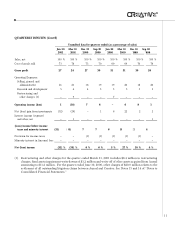Creative 2001 Annual Report Download - page 21
Download and view the complete annual report
Please find page 21 of the 2001 Creative annual report below. You can navigate through the pages in the report by either clicking on the pages listed below, or by using the keyword search tool below to find specific information within the annual report.
21
Research and development
Research and development costs are charged to operations as incurred.
Income taxes
Deferred tax assets and liabilities, net of valuation allowances, are established for the expected future tax consequences
of events resulting from the differences between the financial reporting and income tax bases of Creative’s assets and
liabilities and from tax credit carry forwards. No provision has been made for the undistributed earnings of Creative’s
subsidiaries outside of Singapore since it is Creative’s intention to reinvest these earnings in those subsidiaries.
Reinvested earnings of such subsidiaries have been immaterial to date.
Concentrations of credit risk
Financial instruments that potentially subject Creative to significant concentrations of credit risk consist principally
of cash and cash equivalents and trade accounts receivable. Creative limits the amount of credit exposure to any one
financial institution. Creative sells its products to original equipment manufacturers, distributors and key retailers.
Creative believes that the concentration of credit risk in its trade receivables is substantially mitigated due to
performance of ongoing credit evaluations of its customers’ financial condition, use of short collection terms, use of
letters of credit in certain circumstances, procurement of credit insurance coverage and the geographical dispersion
of sales. Creative maintains an allowance for doubtful accounts based upon the expected collectibility of all accounts
receivable.
Stock-based compensation
Creative accounts for stock-based compensation using the intrinsic value method prescribed in Accounting Principles
Board Opinion (“APB”) No. 25, “Accounting for Stock Issued to Employees”, and related Interpretations. Accordingly,
compensation expense for stock option is measured as the excess, if any, of the fair value of Creative’s stock at the
date of the grant over the stock option exercise price. In addition, Creative provides pro forma disclosures as required
under SFAS 123, “Accounting for Stock-Based Compensation.” See Note 8.
Recently issued accounting pronouncements
In August 2001, the FASB issued SFAS 143, “Accounting for Asset Retirement Obligations.” SFAS 143 addresses
financial accounting and reporting for obligations associated with the retirement of tangible long-lived assets and the
associated asset retirement costs. SFAS 143 will be adopted for Creative’s fiscal year beginning July 1, 2002. Adoption
of SFAS 143 is not expected to have a material impact on the consolidated financial statements.
In July 2001, the Financial Accounting Standards Board (“FASB”) issued FASB Statements Nos. 141 and 142 (SFAS
141 and SFAS 142), “Business Combinations” and “Goodwill and Other Intangible Assets.” SFAS 141 replaces APB
16 and eliminates pooling-of-interests accounting prospectively. It also provides guidance on purchase accounting
related to the recognition of intangible assets and accounting for negative goodwill. SFAS 142 changes the accounting
for goodwill from an amortization method to an impairment-only approach. Under SFAS 142, goodwill will be tested
annually and whenever events or circumstances occur indicating that goodwill might be impaired. SFAS 141 and
SFAS 142 are effective for all business combinations completed after June 30, 2001. Upon adoption of SFAS 142,
amortization of goodwill recorded for business combinations consummated prior to July 1, 2001 will cease, and
intangible assests acquired prior to July 1, 2001 that do not meet the criteria for recognition under SFAS 141 will
be reclassified to goodwill. Companies are required to adopt SFAS 142 for fiscal years beginning after December 15,
2001, but early adoption is permitted. In connection with the adoption of SFAS 142, the Company will be required
to perform a transitional goodwill impairment assessment. Adoption of these statements is not expected to have a
material impact on the consolidated financial statements.
























